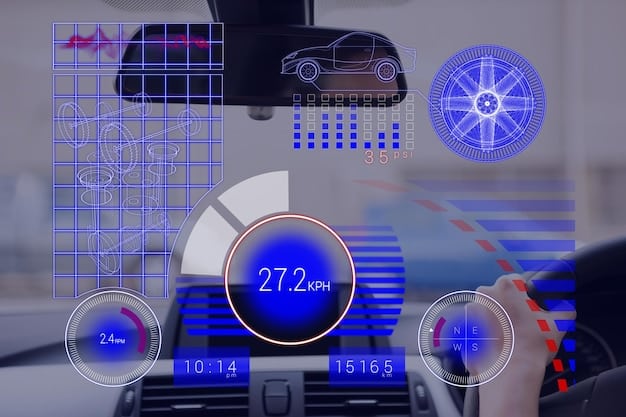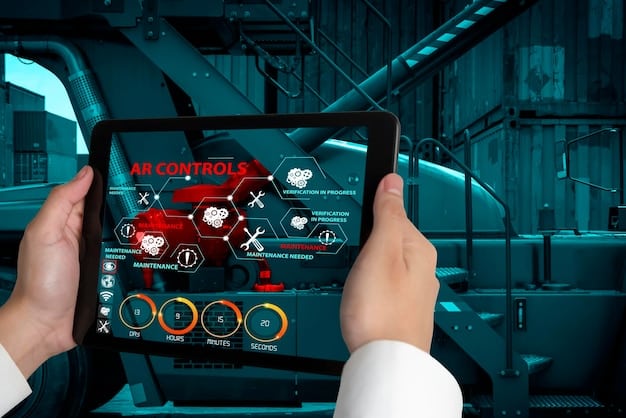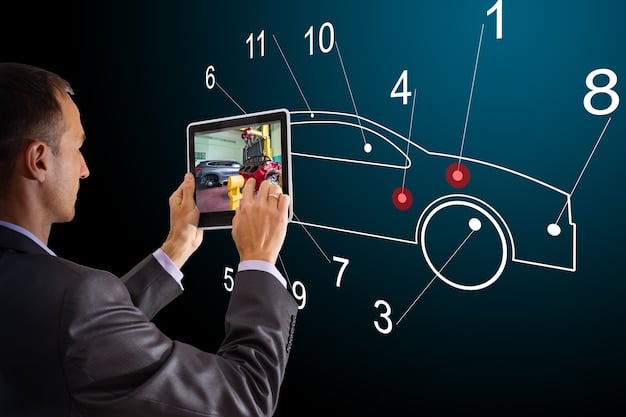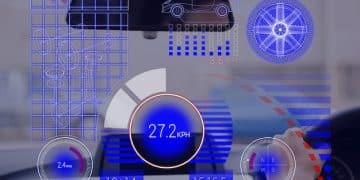Predictive Maintenance: AI’s Role in Preventing Costly Car Repairs

Predictive maintenance leverages artificial intelligence to analyze vehicle data, anticipate potential issues, and prevent costly car repairs before they happen, offering a proactive approach to vehicle maintenance.
Imagine knowing about a potential car problem *before* it leaves you stranded on the side of the road. This is the promise of predictive maintenance, using AI to prevent costly car repairs before they happen, by analyzing data and predicting when maintenance is needed, saving you money and keeping you safe.
Understanding Predictive Maintenance for Vehicles
Predictive maintenance is a game-changer in the automotive industry. It moves away from the traditional “wait-and-see” approach to a proactive system that anticipates and addresses potential problems.
By using sensors, data analytics, and machine learning, predictive maintenance systems can monitor the health of various vehicle components, predict when they might fail, and recommend timely repairs. This not only helps prevent breakdowns but also extends the lifespan of the vehicle.

The Core Components of Predictive Maintenance
Several key elements come together to make predictive maintenance effective:
- Sensors: These collect real-time data on various vehicle parameters, such as engine temperature, oil pressure, and tire pressure.
- Data Analytics: This involves processing the data collected by sensors to identify patterns and anomalies that could indicate potential problems.
- Machine Learning: Algorithms learn from historical data and real-time inputs to predict when a component is likely to fail.
- Communication Systems: These systems alert the driver or maintenance personnel when a potential problem is detected, allowing them to take action.
In essence, predictive maintenance acts as an early warning system, giving vehicle owners and mechanics the information needed to address issues before they escalate into major repairs.
The Role of AI in Automotive Predictive Maintenance
Artificial intelligence is the brain behind modern predictive maintenance systems. AI algorithms are capable of analyzing vast amounts of data, identifying subtle patterns, and predicting future outcomes with remarkable accuracy.
Without AI, predictive maintenance would be limited to basic monitoring and threshold alerts. AI enables the system to go deeper, considering multiple factors and learning from experience to make more accurate predictions.
How AI Enhances Predictive Maintenance
AI contributes to predictive maintenance in several ways:
- Pattern Recognition: AI algorithms can identify complex patterns in vehicle sensor data that would be impossible for humans to detect.
- Anomaly Detection: AI can quickly identify anomalies in vehicle performance that could indicate a developing problem.
- Predictive Modeling: AI can build models that predict when a component is likely to fail based on historical data and real-time inputs.
- Optimization: AI can optimize maintenance schedules to minimize downtime and maximize component lifespan.
These capabilities make AI an indispensable tool for automotive predictive maintenance, enabling more effective and efficient vehicle management.
This proactive approach not only saves time but also contributes to safer driving conditions by addressing potential hazards before they arise.
Benefits of AI-Driven Predictive Maintenance for Car Owners
Predictive maintenance offers a wide range of benefits for car owners, from cost savings to increased safety. By catching potential problems early, car owners can avoid expensive repairs and breakdowns.
Furthermore, predictive maintenance can help extend the lifespan of a vehicle, ensuring that it remains reliable and safe for years to come.
Key Advantages for Vehicle Owners
Here are some of the specific benefits that car owners can expect from AI-driven predictive maintenance:
- Reduced Repair Costs: By addressing minor issues before they become major problems, car owners can save money on repairs.
- Increased Vehicle Lifespan: Predictive maintenance helps extend the life of vehicle components, reducing the need for premature replacements.
- Improved Safety: By identifying and addressing potential safety hazards, predictive maintenance can help prevent accidents and injuries.
- Enhanced Reliability: Predictive maintenance helps ensure that a vehicle is always in top condition, reducing the risk of breakdowns and unexpected downtime.
These benefits make predictive maintenance a valuable investment for any car owner who wants to keep their vehicle running smoothly and safely.
Implementing Predictive Maintenance: What to Expect
Implementing predictive maintenance in a vehicle typically involves installing sensors, connecting to a data platform, and using AI-powered analytics to monitor vehicle health.
While some vehicles may come with built-in predictive maintenance systems, others may require aftermarket solutions. Regardless of the approach, the goal is to collect and analyze data to identify potential problems and recommend timely repairs.

Steps to Implementing Predictive Maintenance
The implementation process typically involves the following steps:
- Sensor Installation: Installing sensors in the vehicle to collect data on various parameters.
- Data Platform Connection: Connecting the vehicle to a data platform that can store and process the collected data.
- AI-Powered Analytics: Using AI-powered analytics to analyze the data and identify potential problems.
- Alert and Recommendation: Receiving alerts and recommendations for necessary maintenance or repairs.
By following these steps, car owners can take advantage of the benefits of predictive maintenance and keep their vehicles in top condition.
The process aims to provide the vehicle owner with comprehensive insights on the vehicle’s condition, promoting reliability and preventing unexpected breakdowns.
Challenges and Considerations for Predictive Maintenance
While predictive maintenance offers numerous benefits, there are also some challenges and considerations to keep in mind. These include the cost of implementation, data security, and the accuracy of predictions.
It’s important to carefully evaluate these factors before implementing a predictive maintenance system and to choose a solution that meets your specific needs and budget.
Addressing Potential Drawbacks
Here are some of the challenges and considerations associated with predictive maintenance:
- Implementation Costs: The initial cost of installing sensors and connecting to a data platform can be significant.
- Data Security: Protecting vehicle data from unauthorized access and cyber threats is crucial.
- Prediction Accuracy: The accuracy of predictions depends on the quality of data and the sophistication of AI algorithms.
- Maintenance Quality: The effectiveness of predictive maintenance relies on the quality of the maintenance and repairs performed.
Addressing these challenges is essential to ensure that predictive maintenance delivers its intended benefits and provides a positive return on investment.
The Future of Predictive Maintenance in the Automotive Industry
The future of predictive maintenance in the automotive industry looks bright, with ongoing advancements in AI, sensor technology, and data analytics. As these technologies continue to evolve, predictive maintenance systems will become even more accurate, efficient, and affordable.
Ultimately, predictive maintenance has the potential to transform the way we maintain and manage vehicles, leading to safer, more reliable, and more cost-effective transportation.
Emerging Trends and Innovations
Here are some of the emerging trends and innovations in the field of automotive predictive maintenance:
- Edge Computing: Processing data locally in the vehicle to reduce latency and improve real-time performance.
- Predictive Analytics: Using advanced analytics techniques to identify complex patterns and predict future outcomes with greater accuracy.
- Integration with Autonomous Vehicles: Incorporating predictive maintenance into autonomous vehicle systems to ensure safety and reliability.
These developments are paving the way for a future where vehicles are constantly monitored, and potential problems are addressed before they can cause any harm.
| Key Point | Brief Description |
|---|---|
| 🛠️ Cost Savings | Reduces repair costs by addressing minor issues before they become major ones. |
| 🛡️ Improved Safety | Identifies potential safety hazards, preventing accidents and injuries. |
| 📈 Extended Lifespan | Extends the lifespan of vehicle components, reducing premature replacements. |
| 📊 Real-Time Monitoring | Provides constant monitoring of vehicle health for timely maintenance alerts. |
Frequently Asked Questions
▼
Predictive maintenance involves using AI and data analysis to foresee when a car component might fail, allowing for timely repairs and preventing bigger, more expensive issues.
▼
AI algorithms analyze data from various car sensors to detect patterns that indicate potential problems, providing insights traditional diagnostics can’t offer.
▼
The main advantages include reduced repair costs, improved vehicle safety, and extended lifespan of car components due to proactive maintenance.
▼
While generally positive, potential drawbacks include initial setup costs, concerns about data security, and the need for reliable data for accurate predictions.
▼
You can implement it by installing aftermarket sensors and connecting to a data platform, though some newer cars may have predictive maintenance features built-in already.
Conclusion
Predictive maintenance, powered by AI, is set to revolutionize car care by enabling proactive repairs, reducing costs, and enhancing safety. As technology advances, it promises even more efficient and reliable vehicle maintenance, securing a future where breakdowns are significantly minimized.





